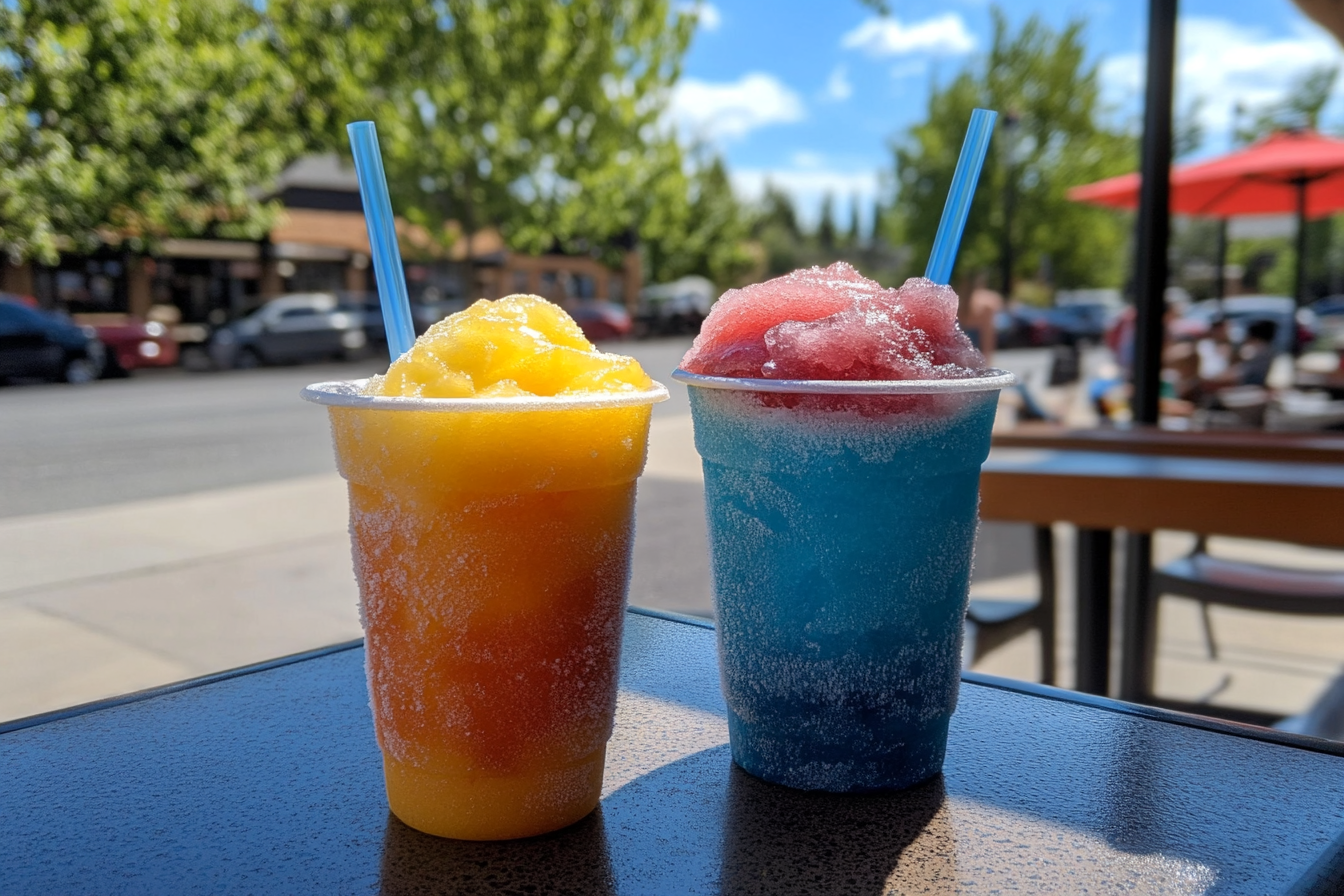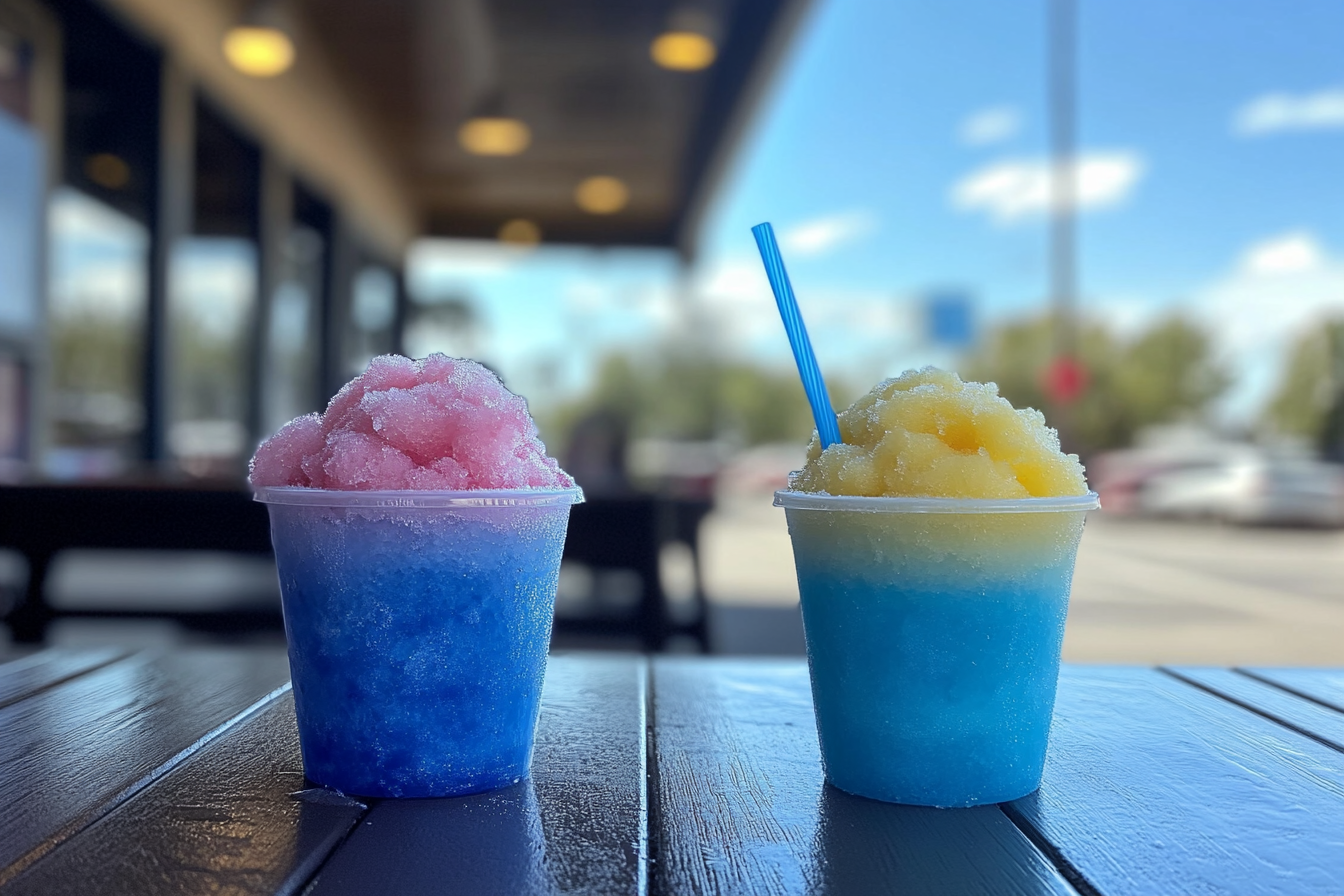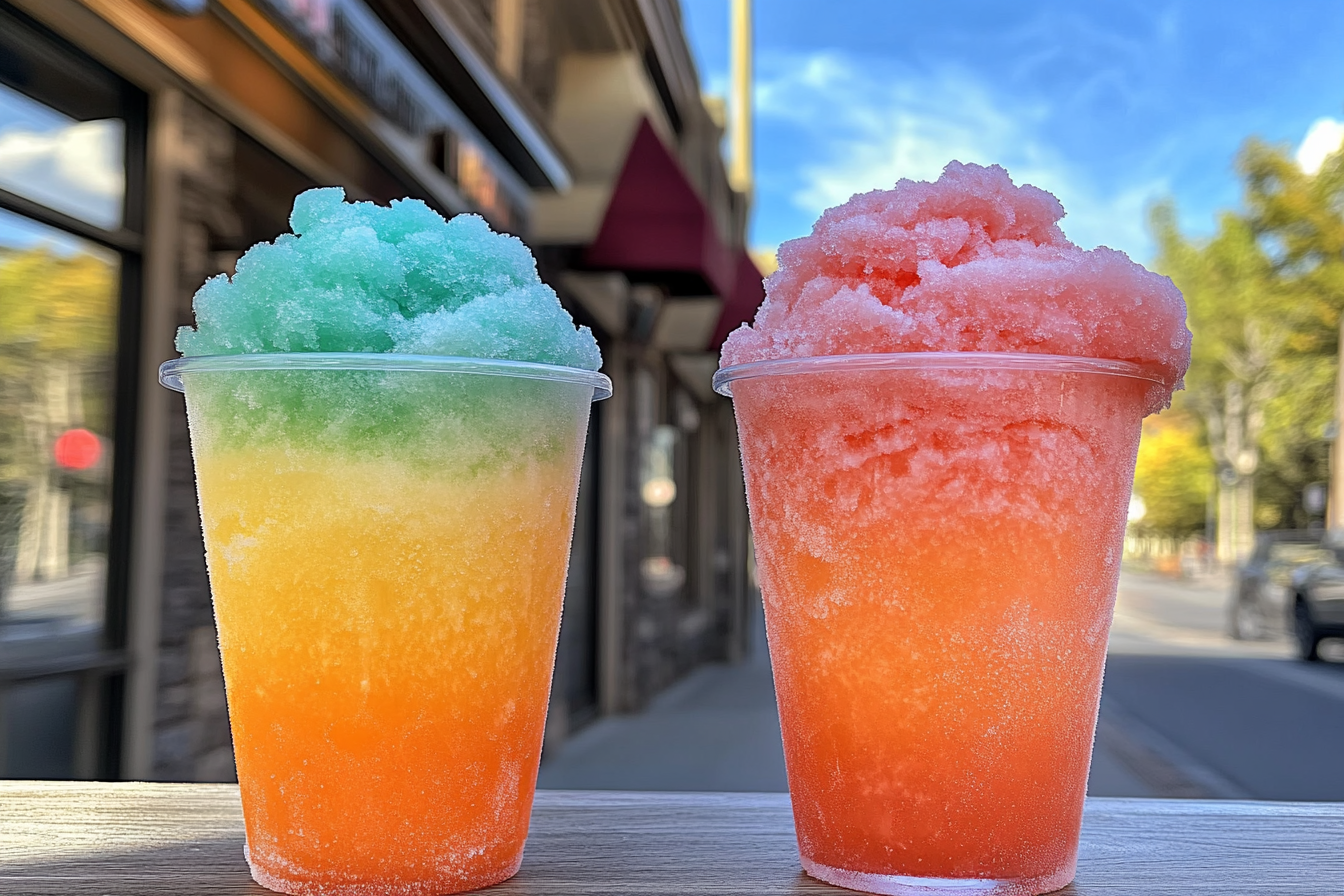snow cone and a slushie? Frozen treats are a staple during the summer months, offering a refreshing escape from the heat. Among the most popular of these treats are snow cones and slushies. While both provide cool, sweet relief, there are several differences between them that affect the texture, flavor experience, and even how they are made. This article explores the key differences between snow cones and slushies, delving into every detail to help you understand which one is perfect for your next summer indulgence.
What is a Snow Cone?
A snow cone is an iconic frozen treat typically made from crushed or shaved ice, which is then topped with flavored syrup. It has a coarse texture that is different from the smoothness of a slushie, giving you something to chew on as you enjoy the treat. The history of snow cones is rich and goes back centuries, originating from early versions of shaved ice desserts in different cultures.
The Origins of Snow Cones
Snow cones have a long and fascinating history. While the modern version became popular in the United States during the 20th century, the concept of flavored ice dates back to ancient times. Shaved ice desserts were enjoyed in places like Japan and Hawaii for centuries before becoming a commercialized product in North America.
Japanese Kakigori: The Original Snow Cone?
One of the earliest forms of shaved ice comes from Japan, where kakigori became a summertime favorite as early as the Heian Period (794 to 1185 AD). This version of shaved ice was served with flavored syrups and often topped with sweetened condensed milk. The key difference between kakigori and modern snow cones is the finer texture of the ice, which resembles freshly fallen snow, giving it a melt-in-your-mouth consistency. Learn more about the history of snow cones, flavors, and recipes for a deeper dive into how this treat evolved across different regions.
Snow cones have a fascinating history that dates back to the 19th century. Learn more about the history of snow cones here.
The Rise of Snow Cones in America
The modern snow cone, with its crunchy texture, rose to fame at state fairs and carnivals in the United States during the 20th century. The invention of the ice crusher made it possible for vendors to serve crushed ice quickly, and soon, snow cones became a popular summer staple. In some regions, snow cones are referred to as “snowballs,” particularly in New Orleans, where they have become a cultural tradition.
How Snow Cones Are Made
To make a snow cone, ice is shaved or crushed to produce larger crystals that are packed tightly together. The ice is placed into a cone-shaped paper cup and topped with a flavored syrup of the customer’s choice. Unlike slushies, which have syrup blended into the ice, snow cones require the eater to mix the syrup into the ice themselves, as it tends to pool at the bottom of the cone. Popular flavors include cherry, blue raspberry, and grape, but regional variations offer even more unique options.
- Ingredients: Crushed ice, flavored syrup
- Texture: Coarse and crunchy
- Serving Style: Typically served in a cone-shaped cup or bowl
- Common Flavors: Cherry, blue raspberry, grape, lemon-lime, and root beer
Snow cones are loved for their satisfying crunch and customizable flavors. However, the experience of eating one differs significantly from that of a slushie, mainly due to its texture.
What is a Slushie?
A slushie differs from a snow cone in its texture and preparation. Rather than using large ice crystals, a slushie consists of finely blended ice that creates a smoother, more consistent texture. This makes it easier to drink through a straw, whereas a snow cone typically requires a spoon or bites from the cone itself. Slushies are popular in convenience stores, fast-food chains, and at movie theaters.
The History of Slushies
Slushies gained mainstream popularity in the 20th century, with the creation of the first Slurpee in the 1960s. The invention of the ICEE machine, which could create a fine slush of carbonated liquid, revolutionized the way people consumed frozen drinks. Since then, many different variations of slushies have appeared on the market, including alcoholic slushies and even energy drink slushies.
How Slushies Are Made
Slushies are made by blending ice into very fine particles and mixing them with syrup. This creates a smooth, drinkable consistency, which is very different from the crunchy texture of a snow cone. The syrup is mixed thoroughly into the ice, ensuring a consistent flavor throughout the drink. Sometimes slushies are made using carbonated liquids, which gives them a fizzy, exciting texture that is popular among kids and adults alike.
- Ingredients: Blended ice, flavored syrup, sometimes carbonation
- Texture: Smooth, fine ice
- Serving Style: Typically served in a cup with a straw
- Common Flavors: Cola, cherry, blue raspberry, lemonade, and green apple
Explore the difference between shaved ice and snow cones for more insight into how the texture of these treats affects their flavor and overall experience.
Key Differences Between Snow Cones and Slushies
When comparing snow cones to slushies, several factors come into play. These include texture, flavor distribution, and how long the treats last before melting.
Texture and Consistency
The most noticeable difference between these two frozen treats is their texture. Snow cones have crunchy, coarse ice crystals that offer a more substantial and satisfying chew. In contrast, slushies provide a much smoother, almost liquid consistency that you can easily sip through a straw.
- Snow Cones: Crunchy, coarse ice crystals
- Slushies: Smooth, fine ice blended with syrup
The texture of a snow cone is more interactive, requiring you to bite or spoon it, while slushies are easier to consume on the go due to their drinkable nature. The texture also affects the way each treat melts, which brings us to the next major difference.
Melting and Temperature Control
Snow cones tend to melt more slowly than slushies, thanks to their larger ice crystals. This means that snow cones last longer in the heat, making them a better option for those looking to enjoy their frozen treat over a more extended period. However, the downside is that the syrup often pools at the bottom, leaving the top layers less flavorful unless stirred. Slushies, by contrast, maintain their flavor throughout the melting process, as the syrup is already mixed into the ice. But they do melt faster, making them a shorter-lived treat.
- Snow Cones: Melt more slowly due to large ice crystals, but syrup tends to settle at the bottom.
- Slushies: Melt faster but maintain consistent flavor as the syrup is fully blended into the ice.
Flavor Absorption and Taste
The way flavor is distributed in a snow cone versus a slushie is another critical difference. Because snow cones have larger ice crystals, the flavored syrup doesn’t fully penetrate the ice and often drips to the bottom. This means that, without mixing, the first few bites may be less flavorful than the last. In contrast, slushies have a more uniform taste since the flavoring is mixed evenly throughout the ice.
- Snow Cones: Syrup tends to settle, requiring stirring for consistent flavor.
- Slushies: Flavor is uniformly mixed, providing consistent taste with each sip.
Flavor intensity can vary depending on how much syrup is used in each, but generally, slushies deliver a more intense flavor profile throughout the entire experience.
Variations and Regional Preferences
Both snow cones and slushies have different regional variations, each with its own unique twist. For example, in Hawaii, vendors often serve shaved ice with exotic flavors like lilikoi (passion fruit) or top it with sweetened condensed milk, reflecting the Japanese influence on the islands. In New Orleans, snowballs are the preferred version of the snow cone, featuring finer ice and richer flavors.
Hawaiian Shaved Ice
Hawaiian shaved ice is closely related to the snow cone but features much finer ice, similar to the texture of snow. This gives the treat a melt-in-your-mouth quality that many find more enjoyable than the crunch of traditional snow cones. Popular flavors include coconut, mango, and passion fruit, and many variations include toppings such as sweetened condensed milk or fresh fruit.
New Orleans Snowballs
In New Orleans, snowballs are a cultural icon, enjoyed by locals and tourists alike. Vendors make New Orleans snowballs with finely shaved ice, unlike traditional snow cones that use crushed ice, which gives snowballs a softer texture. They also come in a wide range of flavors, from classic cherry and grape to unique options like wedding cake and nectar cream.
Convenience Store Slushies
The classic Slurpee or ICEE found at convenience stores is a staple of many childhood memories. These carbonated slushies are made with flavored syrup and blended ice, giving them a fizzy, sweet taste. In recent years, variations of slushies have expanded to include alcoholic versions, making them popular at festivals and summer events for adults.
Health Considerations
While both snow cones and slushies are delicious, they are not known for their nutritional value. Both contain significant amounts of sugar and artificial flavorings, which can lead to a high calorie count, especially when consumed in large portions. However, there are ways to make healthier versions of both treats.
Nutritional Content of Snow Cones
Snow cones can vary in their calorie content depending on the amount of syrup used. Typically, the larger the snow cone, the more syrup is needed, which increases the sugar and calorie content. Some vendors offer sugar-free syrups, which can significantly reduce the calorie count, making snow cones a slightly healthier option for those watching their sugar intake.
- Calories: Around 90-180 per serving, depending on the amount of syrup
- Sugars: High, unless using sugar-free syrup
Nutritional Content of Slushies
Slushies generally contain more sugar than snow cones because the syrup is mixed throughout the ice, providing a consistent flavor from start to finish. Slushies are often made with high-fructose corn syrup and artificial dyes, which can contribute to higher calorie counts. Some variations, especially in fast-food chains or convenience stores, may contain additional calories due to carbonation or added toppings.
- Calories: Around 120-200 per serving, depending on size and syrup content
- Sugars: Higher than snow cones due to fully mixed syrup
Healthier Alternatives
Both snow cones and slushies can be made healthier by opting for sugar-free syrups or natural sweeteners. Using fresh fruit as a flavoring agent is another way to cut down on artificial ingredients. At home, you can blend real fruit with ice for a slushie, or use natural syrups made from fruit juice for a healthier snow cone alternative. Check out these healthy snow cone recipes to find ways to enjoy your favorite treat without the guilt.
FAQs
What is the main difference between a snow cone and a slushie?
The primary difference lies in the texture. A snow cone has a coarse, crunchy texture with large ice crystals, while a slushie has a smoother, drinkable consistency due to the finely blended ice.
Can I make both at home?
Yes, you can easily make both snow cones and slushies at home. Use an ice crusher or blender for snow cones. For slushies, a slushie machine or blender works well. To make them healthier, opt for sugar-free syrups or natural fruit juices.
Why do snow cones melt more slowly than slushies?
The larger ice crystals in snow cones take longer to melt than the fine ice used in slushies, making them last longer in warm weather.
Which one is healthier?
Neither offers significant health benefits due to the high sugar content. However, snow cones typically contain slightly less sugar. Vendors concentrate the syrup at the top rather than mixing it throughout, as they do in a slushie.
Conclusion
What’s the difference between a snow cone and a slushie? In conclusion, both snow cones and slushies offer a refreshing treat on a hot day. However, they differ in texture, flavor distribution, and melting time. Snow cones provide a crunchy, biteable experience with syrup concentrated at the top. This makes them perfect for those who enjoy a more interactive frozen dessert. Slushies, on the other hand, are smooth and sip-able. They offer consistent flavor because the syrup is thoroughly mixed with finely blended ice.
Your choice between the two ultimately depends on personal preference and occasion. If you’re looking for a nostalgic treat with more texture, a snow cone is the way to go. However, if you want something smoother that you can enjoy quickly and easily, a slushie might be your best bet. Both have regional variations and health-conscious alternatives, so there’s plenty of room for customization. No matter which you choose, both will definitely satisfy your craving for something cool and sweet on a hot summer day!



